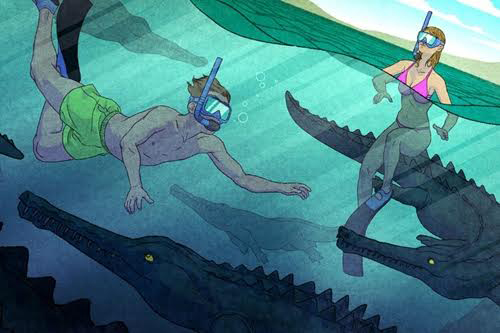Travel to the Arctic in ancient times 55 million years ago
55 million years ago, the Arctic was covered with palm trees while each group of crocodiles swam under the water thanks to the super-powerful greenhouse effect that makes the Earth's climate hotter today.
Travel to the North Pole in ancient times
New Scientist assumes that people can turn back time, travel to the North Pole 55 million years ago. This is the period of maximum temperature increase in the Paleocene-Eocene (PETM) period, Earth's climate is generally hot and humid. Warm sea water and the deepest temperature around 8 degrees Celsius.

People can swim and soak in the ancient Arctic Ocean.(Artwork: Morgan Scheweitzer.)
Under such conditions, the sea level in the Arctic Ocean is about 70 meters higher than today. The ocean is now inhabited by Champsosaur - an ancient crocodile. Many studies show that for this crocodile to survive, the lowest temperature of the year is only at 5 degrees C. While the average temperature of the Arctic is currently around -34 degrees Celsius, a Very big difference.
Going along dense forests and marshes in the Arctic at the time, Cryphodon , the ancestor of today's hippopotamus , is immersed in water.
Fast-forward time of several million more years, more freshwater turtles appear in the Arctic. Fresh water flows from the Arctic river basins and forms many large and even largest lakes in Earth's history. The lake becomes an ideal place to swim, with water temperatures around 23 degrees C. At the other end of the world, Antarctica also has similar weather.
"When the temperature peaks in the PETM period, you can see ferns in Antarctica. The climate is very hot and humid," said Dr. Kate Littler, University of Exeter.
The cause of the hot climate on Earth at this time was the existence of a large amount of greenhouse gases in the atmosphere. But where did that gas come from, but no scientist would dare to assert.
Many opinions concur with the possibility of the strong volcanic system on the planet has made the atmosphere flooded with greenhouse gases.
Another theory is that the cause of the melting of seabed metane ores releases methane into the air. Or it could be due to CO2 coming out of the Antarctic permafrost .
Over millions of years of gradual warming, the Earth's temperature suddenly increased by 5 degrees Celsius within 20,000 years. Abnormal warming causes creatures living in the ocean to have problems with mass adaptation and extinction.
Meanwhile on the ground, resurrection enters a flourishing development period. Fauna and flora species grow not only at the two poles but around the world.
If dropped into a dense tropical forest in Southeast Asia at that time, it will be encountered animals that look similar to today's Tarsier dwarf monkeys . These are the first primates in history. And in the future, they will evolve to become a single species that rises to dominate the world: people.
The PETM period ended and the Earth's temperature returned to normal as it is today after 200,000 years. Now, however, human development seems to lead to a warming even 100 times faster than PETM.
Despite many worries, there are still suggestions that the imminent global warming will once again promote life to develop and bring a new future to the Earth.
- The North Pole sinks in the dark winter 53 million years ago
- Bacteria sleep 100 million years in the Arctic Ocean
- The Arctic is burning, threatening to open the ancient 'ice tomb' full of poisonous gas
- Surprise the planet reversed hundreds of times right in the Solar System
- Discovered a $ 5.3 million meteorite in the field
- Arctic sea ice area is at a record low
- The Arctic lost three times as much ice as Belgium every day
- Bird fossils 90 million years help predict the future of the Earth
- Trilobita - The Mistress of ancient times
- The Arctic ice melted four times faster than forecast
- Arctic will melt ice after 5 years
- The Arctic temperature is the highest in 44,000 years
 'Fine laughs' - Scary and painful torture in ancient times
'Fine laughs' - Scary and painful torture in ancient times The sequence of numbers 142857 of the Egyptian pyramids is known as the strangest number in the world - Why?
The sequence of numbers 142857 of the Egyptian pyramids is known as the strangest number in the world - Why? History of the iron
History of the iron What is alum?
What is alum?